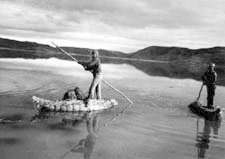


These three samplings of Peruvian photography span nearly a century of time, a period in which Peru has changed enormously. It has gone from a pre-capitalist society with serfs and manors to a cut-throat free-market free-for-all. These pictures captured those moments and pictures offered unfiltered views of this enormous swinge of change. There is a rapport between the photographers and their subjects, a complicity in portraying who and what they are.
For those interested in other approaches, RCP has brought together a collection links and commentaries on Peruvian photograpy. Also see Centro de la Fotografia ::: Courret Collection ::: Peruvian Photography 1850-1950 by Yolanda Retter ::: Peruvian Photographers/Humanities-Interactive, Texas
 TAFOS--Social Photography Workshops: it was an innovative group of people who encouraged and assisted groups of grassroots photographers among the Andean campesinos, mine workers and Lima shanty town residents for more than a decade. Unfortunately, the group stopped working in 1997. Its archive resides at the Catholic University of Peru. I have special permission to use TAFOS material throughout this site as a representation of a special time in popular culture. A small sampling of their work is brought together here. If you are interested in finding out more, you can contact Tomás Muller
TAFOS--Social Photography Workshops: it was an innovative group of people who encouraged and assisted groups of grassroots photographers among the Andean campesinos, mine workers and Lima shanty town residents for more than a decade. Unfortunately, the group stopped working in 1997. Its archive resides at the Catholic University of Peru. I have special permission to use TAFOS material throughout this site as a representation of a special time in popular culture. A small sampling of their work is brought together here. If you are interested in finding out more, you can contact Tomás Muller ![]() .
.
![[ Enlistment of Peasants, 1935 Horacio Ochoa, 1905-78 ]](../images/pe_ochoa.gif) The social research center Centro Bartolemé de las Casas (CBC) in Cusco has a unique photography archive, the Fototeca Andina.
The social research center Centro Bartolemé de las Casas (CBC) in Cusco has a unique photography archive, the Fototeca Andina.
It is stocked with pictures taken by local photographers in the early 1900s. These pictures provide unique portraits of the era. The center's web site focuses on six photographers, but it has thousands more in its archive. This trove of photos, like others elsewhere, have become rallying points for regional identity and pride in a long-standing rivalry with Lima. The web site is in Spanish.
![[ Martin Chambi and mule ]](../images/pe_chambi2.jpg) The first Peruvian photographer whose plates and film showed themselves to be a rich vein of discovery, regional history and artistic value was
Martin Chambi.
The first Peruvian photographer whose plates and film showed themselves to be a rich vein of discovery, regional history and artistic value was
Martin Chambi.
He made his living by taking portraits of the middle and upper class in Cusco in the 1920s and 30s. He also recorded the working class and campesinos. His glass plates were restored in late 1980s and have been drawing attention ever since then.